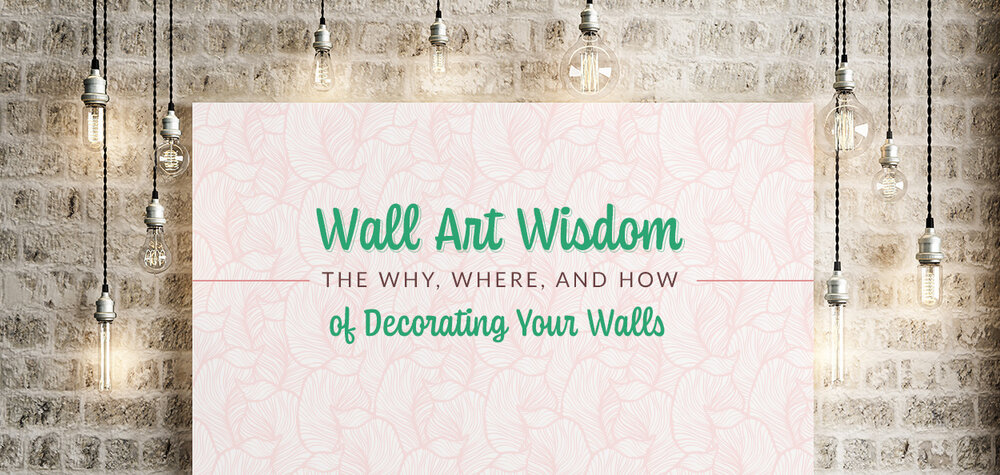Whether it’s a large abstract art piece or small family photo, hanging wall art can be a tricky task. Opinions come into play and the obvious questions of location and placement hang in the air. While there is no strict right and wrong when it comes to decorating your own home, there are certain guidelines that can help you through the process. Learn some wall art wisdom with these wall decor tips.
Hanging Wall Art: The Why
Before diving into the “where” and “how” of hanging wall art, it’s important to know the “why” that drives each decision.
Choosing the Right Size Wall Art
When it comes to arranging wall art, size is everything. You should choose the size of the art based on the amount of wall space you have to work with. If you’re looking to decorate a stand alone wall, you can follow the popular rule of thumb that says artwork should take up four-sevenths of the wall on which it is placed. Start by measuring the length and width of the chosen wall, then multiply each measurement by .571 (four-sevenths as a decimal) to get the appropriate size.
If you’re hanging wall decor behind a piece of furniture, you can be a little more liberal with your measurements. Simply eyeball the wall art against the furniture and look to see if it’s close to two-thirds the size. The general rule is that the art should be slightly smaller in length than the object you’re placing it behind.

Hanging Wall Art: The Where
Now that you know about appropriate wall art sizes, you can move on to the finer details of placement and location. Deciding where to hang wall art can be tough with so many walls to choose from, but here are a couple of wall decor tips to give you a better idea.
Find the Focal Point of the Room
Before making any rash decisions, take the time to find the focal point of the rooms within your home. Focal points are the part of a room that the eye is drawn to first, which makes it the perfect spot for hanging wall art. An example would be a fireplace in the living room. Find these focal points, and you’ve got yourself designated spaces to decorate.
While focal points are important, don’t feel limited by them. You can still hang wall art in other areas of the home, but this is a great place to start.
Hang Close to Eye Level
Although interior designers usually recommend hanging wall art at eye level, there is a new school of thought that says the center of artwork should be placed closer to 57 inches from the floor. The reasoning being that every person has a different definition of what eye level is.
Deciding which school of thought you’re in is up to you, but remember, it’s just a general guideline. Go with your preference and feel out the space of the room. If you have high ceilings, feel free to raise your art slightly above 57 inches to fill up the space more evenly.

Hanging Wall Art: The How-To
Once you have figured out the why and where of hanging your wall decor, it’s time to break out the hammer and nails to get it done. This is the part of hanging wall art that requires lots of patience and precision!
Rather than jumping straight into it, follow these steps to get a visual of the end product before it’s too late. Hanging wall art this way also allows you to do it alone, rather than with two people.
Step 1: Trace your wall art on a piece of paper.
Step 2: Cut out the tracing to use as a template.
Step 3: Make a mark on the template to show where the picture wire or hook will be by measuring out the same distance from the wire to the top of the frame.
Step 4: With the marked side facing out, match up the nail mark on your template to the nail mark on the wall and secure it in place with tape.
Step 5: Step back and take a look at the placement. Make adjustments as necessary and then you’re ready for the real thing!
Ideas for How to Arrange Wall Art
Depending on how many pieces you have, there are lots of options for how to arrange wall art. Depending on size, shape, and subject matter, you can group your artwork differently to achieve more or less balance. Get inspiration for your pieces by taking a look at these unique ways of arranging wall art.
Symmetrical Arrangement
Just as the name suggests, a symmetrical arrangement gives the wall art a visual balance that is uniform and consistent. This is a good option for pieces that are similar in shape, size, and subject matter. Place them over furniture collections or fireplaces to add depth to the focal point.
Keep in mind that a grouping of art pieces should be spaced no more than 6” apart, with 2” to 3” being optimum.
Asymmetrical Arrangement
Arranging wall art asymmetrically works best for pieces that have at least one element in common like color scheme or subject matter. You can stagger them by placing one lower than the other, or vice versa, to create an organic balance.
A wall decor tip to remember for these sorts of arrangements is to hang the largest pieces first and work from there. Don’t be afraid to group small with big, as well as vertical with horizontal. Combining pieces creates interest and energy.
Now that you know the why, where, and how of wall art wisdom, you can decorate your home with more confidence and expertise! Have fun with it and remember that these tips for hanging art are just guidelines, not steadfast rules. Be creative and do what you like best. Once you’re finished, learn how to measure furniture the easy way!


